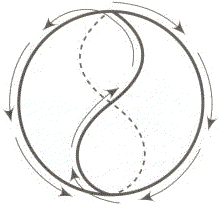by Dan Miller
[Adapted and re-edited by F. Hriadil]
In the traditional method of Lu Shui-Tian as taught by Master Bok-Nam Park, all students begin their circle walking training with Basic Circle Walking. Basic Circle Walking consists of walking and changing direction along the periphery of a circle.
Yin-Yang Circle Walking and Single Pole Training
Once a level of proficiency is attained, the training progresses to Yin-Yang Circle Walking. Yin-Yang Circle Walking adds walking through the middle of the circle to the practice. The basic pattern is shown in the Taiji (T’ai Chi) symbol illustration below (where the arrows indicate the walking direction).

In this pattern, palm changes are executed as the practitioner transitions through the middle of the circle. A pole or tree is usually located at the center of the circle. Palm changes and directional changes are executed during, and coordinated with, the movement towards and around the central pole. The pole, or tree, is treated as if it is an opponent.
Certain elements are critical during this practice. They include:
- The rhythm and smoothness of the stepping.
- The timing of the palm change.
- The ability to keep one’s center towards the opponent.
When moving towards and around the pole, the body must turn or twist around its central axis as the palms are changed. A consistent optimum angle must be maintained in relation to the opponent. This is accomplished by turning the hips and shoulders appropriately during the transition. The timing of the palm change and the rotational movements of the arms must be well-coordinated with the rotating torso of the body.
Palm Changes in Pole Training Practice
All of Ba Gua’s various palm changes are utilized in the pole training practice. Students generally begin with the basic “Fan Zhang” changes: Straight Fan Zhang, Circle Fan Zhang, and Sky Overturning Fan Zhang. Later, the “Eight Primary Palms,” learned during Basic Circle Walking, are incorporated. By utilizing all of these movements in the pole training practice, the student’s experience grows and he/she becomes more proficient with Ba Gua’s various arm movements, and rapid twisting and turning body movements. When the arms, legs, and body become well-coordinated throughout the tight twists and turns of the pole training, the student will come to understand many new applications for the basic movements. Note: [A lot of Ba Gua’s throwing techniques come out of these changes.]
Two Pole and Three Pole Training with the Figure Eight Pattern
The Yin-Yang Pattern is the first of many patterns that are practiced as part of the “pole training” method of Lu Shui-Tian. After the student has practiced the Yin-Yang Pattern around one central pole and become proficient in the mechanics and timing of its movements, he/she will then start to practice walking a “Figure-Eight” Pattern around two poles. From there, the student progesses to walking a double Figure-Eight Pattern around three poles.
When working with either the two or three pole configuration, the distances between the poles are not always the same. The pole separation is varied so that the student can become accustomed to navigating smaller and larger figure-eights.
For example with three poles, the distance between each of the poles will be different so that the first figure-eight around pole #1 and pole #2 will be smaller and the subsequent figure-eight around pole #2 and pole #3 will be larger. The student will also practice small circles around the various individual poles in conjunction with the Figure-Eight Patterns. In other words, the practitioner might execute two consecutive Figure-Eight Patterns around the three poles, then execute a full circle or two around pole #1 before returning to the Figure-Eight Pattern again.
Varying the patterns gives the student experience in varying the timing of the palm changes, varying the stepping characteristics, and varying the coordination of the body’s turning and twisting movements.
Walking in smaller, tighter circles, and changing directions frequently, facilitates the development of Ba Gua’s “kou bu” and “bai bu” steps. The ability to apply “kou bu” and “bai bu” quickly and efficiently enables the practitioner to change directions rapidly. It develops flexibility and dexterity in the body’s pelvic region. And, it is essential for developing the ability to utilize “kou bu” and “bai bu” to hook or trap an opponent’s legs.
Striking and Kicking in Pole Training Practice
Once the student becomes proficient at maneuvering around and through the poles while utilizing the basic arm movements of the “Eight Primary Palms,” he/she will then begin to add striking and kicking to the pole training practice. The poles are made from bamboo, rattan, PVC pipe, or some other flexible material that has one end stuck into the ground. The practitioner can kick or strike a pole and, since the pole has some give to it, it will absorb some of the energy of the strike and bounce back. In pole striking practice, the practitioner never stops moving around and through the poles, while changing directions rapidly and kicking or striking the poles. Some poles are kicked, some are hit, and others are not touched but are evaded as the student continually moves around the poles. In this practice, the student learns to strike while remaining highly mobile and learns how to quickly change and move after a strike has been executed.
Four Pole and Five Pole Training
After the three pole practice, the student moves on to four poles arranged in a square pattern, and then to five poles with the additional pole placed at the center. Again, the distances between the poles start out the same, then later, they are varied.
Six Pole to Nine Pole Training
After the five pole practice, the student will continue adding poles, one at a time, as his/her skill level improves, until there are a total of nine poles, with one at the center and one pole at each the eight Ba Gua directions around the circumference. This is Ba Gua’s famous “Nine Palaces” pole training practice.
Many schools of Ba Gua practice the “Nine Palace” pole method. Master Park believes that it is important to carry out pole training in gradual steps – starting first with one pole, then two poles, then three poles, etc. over a gradual period of time. The training should progress in a step by step manner. As each successive pole is added, a new dimension is added to the practice. If the practitioner is unable to execute the proper movements when walking around two poles, then adding more poles prematurely only creates excess complexity and confusion – both of which are detrimental to the practitioner’s development.
There are many different “games” that are “played” while practicing pole training. These are done to develop different Ba Gua fighting skills. Some poles are kicked, some are hit, some are avoided, and the circular pattern is always varied. Sometimes small circles are performed, sometimes larger circles are performed, sometimes the figure-eight pattern is utilized, sometimes a spiraling pattern is employed,etc. All possible variations are explored.
As an example, when Master Park practiced the nine pole method with his teacher, Lu Shui-Tian, Lu would tie a small rope to the top of each of the bamboo poles. As Master Park was circling, moving, and navigating through and around the poles, Lu would pull on one of the ropes causing the pole to which it was attached to shake. When Master Park noticed a shaking pole, he would immediately have to move in to attack that pole. There are many such modifications that are utilized to enhance the “Nine Palace” pole training.
Tepee Pole Training
In Master Park’s method, the pole training practice does not end with the “Nine Palace” pole arrangement. After the student has become proficient with working the nine poles, the center and four diagonally positioned poles are removed. The remaining four poles are then tilted in towards the center to form a “Tepee” shape.In this “Tepee” configuration, a height variable is now added to the practice. Here, the student must not only maneuver around the poles, he/she must also maneuver under the poles. While walking, circling, and turning, the practitioner must continually adjust his/her body height in relation to the angled poles. As the training progresses, the angles of the poles are varied.
Training to Fight
In the application of Ba Gua Zhang as a fighting art, the practitioner must learn to be highly mobile and evasive, while at the same time moving in to continuously attack the opponent. Evasion in Ba Gua Zhang does not mean running away or retreatng to escape an attack; rather, it means avoiding the opponent’s force and strength while simultaneously counterattacking at the most efficient angle possible, and, furthermore, continually changing and maneuvering to maintain an efficient attacking angle until the opponent is overcome and the fight is ended. The advanced circle walking practice that comprises Master Park’s traditional Ba Gua Zhang method is specifically designed to help the Ba Gua practitioner begin to develop the extraordinary fighting ability that Ba Gua Zhang is famous for.
[ Above is an adaptation and re-editing of the article “Advanced Circle Walking: Training to Fight” by Dan Miller that originally appeared in the PA KUA CHANG JOURNAL – Vol. 4, No. 6; Sep/Oct 1994. The Journal was published by High View Publications . It is no longer being produced; however, all back issues are currently available on CD-ROM .]

